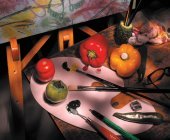|
Flash LightFlash light or electronic flash is a good substitute for natural light. It has become a standard form of source of light for professional photographers. Electronic flash contains a flash tube, which throws a burst of light when it gets electrical power. This power is provided to the flash tube by capacitors. A capacitor is an electrical device, which can store electrical energy and when triggered, it will release all its energy at once.
Portable electronic flashes, which are to be mounted directly on a camera hot shoe, are of three types: Manual Flash Automatic Thyristor Flash Dedicated Flash
Read more about how guide number is used in flash photography. Manual flash is mostly used by wedding and press photographers. We have to manually set aperture, which depends on the distance between the camera (or flash light) and the subject.
Automatic Thyristor Flash : This design has a built-in light sensitive photo-cell. It measures the amount of light reflected back from the object and controls the output of power by stopping the electrical charge and light, when proper exposure is complete. So if we have set our lens aperture on f5.6, and shooting an object at 10 feet, the flash, even if it is rated at guide number 110, will not throw all its light and give us a correct exposure. Dedicated: This version of flash will work with its own brand of camera (and model) and perform different task, for which it is designed. Depending on the design - it may assist on auto-focus mechanism, work with the program mode, set the camera automatically to its synchronized shutter speed, or work at any aperture on aperture priority setting. All these portable flashes are calibrated to give correct exposure in a room (of a size 10’ x 12’) which has light colored walls and white ceiling. So should you shoot in a bathroom, (which is much smaller and has glazed tiles) you should use one stop smaller aperture, and for a large room, open up aperture by one f stop. Studio Flash: This flash is totally independent unit, which has to be mounted on its own stand. It can take other accessories like umbrellas, snoot, soft box and honey comb to modify the light quality. Flash light contains a modeling lamp, a much less powerful light bulb, to show the effect of light falling on the object. When a flash is fired, the bulb will go off and the flash tube will throw a burst of light. It also contains a slave unit, which is a switch, sensitive to light. This means that all other lights will fire at the same time, when one studio light is fired, although they are not directly connected with each other with any wire.
When multiple flashes are set for lighting, you will need a flash exposure meter, which is a specially designed light meter to read exposure of flash lights. You can individually take readings from each light and determine the contrast ratio created by lights.
Read more about studio lights.
Read about light attachments used in photography
Return back to Accessories from Flash light
|






